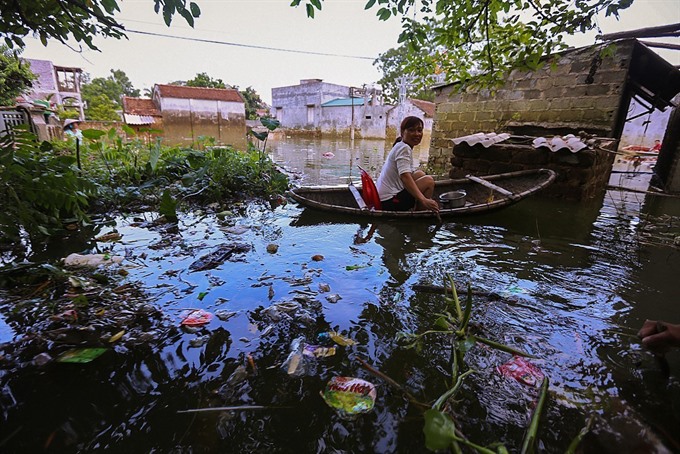 Environment
Environment

Waste collection and treatment in rural areas have been improved in recent years, but local authorities hope new electricity generation technology and projects will help resolve waste problems more sustainably and effectively.
 |
| A resident of Hà Nội's outskirt district of Chương Mỹ collects waste that floated in through drainage systems following the historic flood in mid-2018. — VNA/VNS Photo Trọng Đạt |
HÀ NỘI — Waste collection and treatment in rural areas have been improved in recent years, but local authorities hope new electricity generation technology and projects will help resolve waste problems more sustainably and effectively.
Overloaded waste treatment zones
Rubbish was strewn around a field in Tam Hiệp Commune in Hà Nội’s Phúc Thọ District. The road connecting the centre of south Hà Nội and Kim Bài Town in Thanh Oai District, which is only four kilometers long, has a number of small rubbish dumps impeding traffic.
Nguyễn Tiến Hải, director of the Thanh Oai Investment and Construction Project Management Board, said that on average, the district discharges about 90 tonnes of rubbish per day. As much as 85 tonnes is transported to treatment areas, but the remaining waste is left untreated.
Statistics of the Hà Nội Construction Department showed that the capital city discharged between 6,500 and 7,000 tonnes of rubbish each day. About 88 per cent of daily rubbish in rural areas was treated.
Most of the rubbish was treated and buried in two main areas. The first is the Nam Sơn Waste Treatment Complex in Sóc Sơn District – which receives about 4,500 to 5,000 tonnes of rubbish per day – and the second is the Xuân Sơn Solid Waste Treatment Zone in Sơn Tây Town, Ba Vì District – which receives 1,200 to 1,500 tonnes of rubbish per day.
This process takes a lot of space, so the two areas are always overloaded and pollute the surrounding area.
Lê Thị Hải, deputy director of the Sóc Sơn Natural Resources and Environment Division, said the Nam Sơn Waste Treatment Complex had a total area of nearly 160 hectares and was designed to operate until 2020 with capacity of about 1,000 tonnes per day. However, the amount of rubbish it received was nearly five times its designed capacity.
Hải said the Xuân Sơn Solid Waste Treatment Zone could treat contaminated water leaking from the waste, but the burial still affected the environment.
In prior years, the municipal authorities allocated hefty funds for pollution treatment caused by dumps, and supported residents living in the affected areas by building waste water collection and treatment systems, planting trees and installing a clean water system. But these efforts proved insufficient in treating the pollution.
The city has several plants converting rubbish into fertiliser, but their capacity is small – just 600 tonnes per day. They are often used to treat industrial waste.
High-tech waste treatment plants
Hoàng Dương Tùng, former deputy director of the Vietnam Environment Administration under the Ministry of Natural Resources and Environment, said burying waste was not an efficient use of space and raised new environmental issues.
The Nam Sơn Waste Treatment Complex is the biggest rubbish dump in Hà Nội, but it is expected to be full by 2020.
Hà Nội needs a plan to treat waste with modern technology, he said.
To treat waste in rural areas, Hà Nội authorities have called for investment in electricity generation technology projects.
The Hà Nội Department of Construction said that in the period from 2020 to 2021, the city would build four high-tech waste treatment plants. One of these will be in the Nam Sơn Waste Treatment Complex, two will be in the Xuân Sơn Solid Waste Treatment Zone and the remaining one will be in the Đồng Ké Solid Waste Treatment Zone in Chương Mỹ District.
Construction will start on the Sóc Sơn Waste Electricity Plant in the Nam Sơn Waste Treatment Complex, with a capacity of 4,000 tonnes per day, by the beginning of next year. It is scheduled to be operational in 2020.
Two electricity generation plants in the Xuân Sơn Solid Waste Treatment Zone have a total capacity of 1,500 tonnes per day and night. They will be built in April next year. The remaining plant in Chương Mỹ District is waiting for an investor. — VNS




